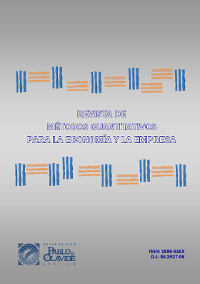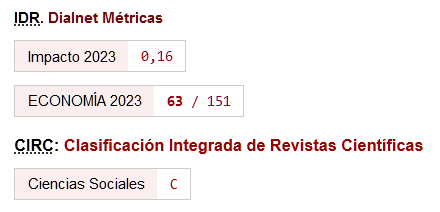Spurious Rejections by Dickey-Fuller Tests in the Presence of an Endogenously Determined Break under the Null
DOI:
https://doi.org/10.46661/revmetodoscuanteconempresa.2145Keywords:
Unit roots, structural breaks, Dickey-Fuller tests, raíces unitarias, cambios estructurales, test Dickey-FullerAbstract
Leybourne et al. (1998) have proved the possibility of a ‘converse Perron phenomenon’ when conventional Dickey-Fuller tests are applied to determine the order of integration of a time series. That is, if the true generating process is I(1) but with a break, frequent spurious rejections of the null hypothesis can occur. Although Leybourne et al. (1998) suggest it would be appropriate to use procedures in which the break date was treated as endogenous, they consider it as exogenous. Thus, this paper analyses whether their results change when the structural break is identified endogenously, that is, if the break point is gleaned from the data. In this sense, applying a recursive tDF test to a unit root process which has a break in its level, there is no virtually evidence of the ‘converse Perron phenomenon’. For the rest of the endogeneization procedures (i.e., rolling and sequential) and for the two types of breaks considered (in level or in drift), we find, in line with Leybourne et al. (1998), some distortion in the Dickey-Fuller tDF test size, which depends on the break size, the location of the break point in the sample and the sample size.
Downloads
References
Banerjee, A., Lumsdaine, R.L. and Stock, J.H. (1992) Recursive and sequential tests of the unit-root and trend-break hypotheses: Theory and international evidence, Journal of Business & Economic Statistics, 10, 271–87.
Christiano, L. J. (1992) Searching for a break in GNP, Journal of Business and Economic Statistics, 10, 237–250.
Dickey, D. and Fuller, W. (1979) Distribution of the estimators for autoregressive time series with a unit root, Journal of the American Satistical Association, 74, 427–431.
Fuller, W. A. (1976) Introduction to statistical time series. New York, Willey.
Granger, C.W.J. and Newbold, P. (1974) Spurious regressions in Econometrics, Journal of Econometrics, 2, 111–120.
Leybourne, S., Mills, T. and Newbold, P. (1998) Spurious rejections by DF tests in the presence of a break under the null, Journal of Econometrics, 87, 191–203.
Nelson, C.R. and Plosser C.I. (1982) Trends and random walks in macroeconomic time series: Some evidence and implications, Journal of Monetary Economics, 10, 139–162
Perron, P. (1989) The great crash, the oil price shock and the unit root hypothesis, Econometrica, 57, 1361-1401.
Perron, P. (1994) Trend, unit root and structural change in macroeconomic time series. In Rao, B. B. (ed), Cointegration for the Applied Economists. MacMillan, New York, NY, 113–146.
Perron, P. (1997) Further evidence on breaking trend functions in macroeconomic variables, Journal of Econometrics, 80, 355–385.
Perron, P., Vogelsang, T. J., (1992) Nonstationarity and level shifts with an application to purchasing power parity, Journal of Business and Economic Statistics 10, 301–320.
Vogelsang, T. J., Perron, P. (1998) Additional tests for a unit root allowing for a break in the trend function at an unknown time, International Economic Review 39(4), 1073–1100.
Yule, G.U. (1926) Why do we sometimes get nonsense correlations between time series? A study in sampling and the nature of time series, Journal of the Royal Statistical Society, 89, 1–64.
Zivot, E., Andrews, D.W.K., (1992) Further evidence on the Great Crash, the oil price shock, and the unit root hypothesis, Journal of Business and Economic Statistics 10, 251–270.
Downloads
Published
How to Cite
Issue
Section
License
Copyright (c) 2010 Revista de Métodos Cuantitativos para la Economía y la Empresa

This work is licensed under a Creative Commons Attribution-ShareAlike 4.0 International License.
Submission of manuscripts implies that the work described has not been published before (except in the form of an abstract or as part of thesis), that it is not under consideration for publication elsewhere and that, in case of acceptance, the authors agree to automatic transfer of the copyright to the Journal for its publication and dissemination. Authors retain the authors' right to use and share the article according to a personal or instutional use or scholarly sharing purposes; in addition, they retain patent, trademark and other intellectual property rights (including research data).
All the articles are published in the Journal under the Creative Commons license CC-BY-SA (Attribution-ShareAlike). It is allowed a commercial use of the work (always including the author attribution) and other derivative works, which must be released under the same license as the original work.
Up to Volume 21, this Journal has been licensing the articles under the Creative Commons license CC-BY-SA 3.0 ES. Starting from Volume 22, the Creative Commons license CC-BY-SA 4.0 is used.










